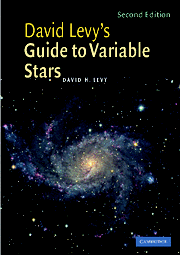Book contents
- Frontmatter
- Contents
- Foreword to the first edition
- Preface
- Acknowledgments
- Part I Getting to know the sky
- Part II Getting to know the variables
- 5 Meeting the family
- 6 Getting started with Cepheids
- 7 Algol, the demon of autumn
- 8 How to estimate a variable
- 9 Names and records
- 10 How your observations help us understand a variable star
- 11 Observing hints
- 12 Observing with CCDs
- 13 Stately and wonderful
- 14 Stars of challenge
- 15 Bright, easy, and interesting
- 16 Betelgeuse: easy and hard
- 17 Not too regular
- 18 Nova? What nova?
- 19 Supernovae
- 20 Clyde Tombaugh's star and the family of cataclysmic variables
- 21 A nova in reverse?
- 22 RU Lupi?
- 23 Orion, the star factory
- 24 Other variable things
- 25 The Sun
- Part III Suggested variables for observation throughout the year
- Part IV A miscellany
- Index
24 - Other variable things
from Part II - Getting to know the variables
Published online by Cambridge University Press: 05 August 2012
- Frontmatter
- Contents
- Foreword to the first edition
- Preface
- Acknowledgments
- Part I Getting to know the sky
- Part II Getting to know the variables
- 5 Meeting the family
- 6 Getting started with Cepheids
- 7 Algol, the demon of autumn
- 8 How to estimate a variable
- 9 Names and records
- 10 How your observations help us understand a variable star
- 11 Observing hints
- 12 Observing with CCDs
- 13 Stately and wonderful
- 14 Stars of challenge
- 15 Bright, easy, and interesting
- 16 Betelgeuse: easy and hard
- 17 Not too regular
- 18 Nova? What nova?
- 19 Supernovae
- 20 Clyde Tombaugh's star and the family of cataclysmic variables
- 21 A nova in reverse?
- 22 RU Lupi?
- 23 Orion, the star factory
- 24 Other variable things
- 25 The Sun
- Part III Suggested variables for observation throughout the year
- Part IV A miscellany
- Index
Summary
What else does the sky have that varies? Besides stars, there are other objects worth noting. Some are easily visible, and others are beyond the reach of all but the most powerful telescopes and detectors. They range in distance from a few million kilometers to billions of light years.
Variable nebulae
In the constellation of Monoceros is a variable star called R. It varies irregularly by about half a magnitude around 11. However, the star is usually very hard to see. The reason is that it is embedded in a nebula which also varies in brightness! This object is known as Hubble's variable nebula, NGC 2261, after the Mount Wilson astronomer who, in 1916, discovered that it varies in brightness, size, and even shape. The variation does not seem to follow the brightness changes in R Mon, and they do not occur with any regularity.
R Monocerotis and its nebula probably represent a planetary system in an early stage of formation. At least two other variable nebulae are known, NGC 1555 in Taurus, and a tiny wisp in Corona Austrina, NGC 6729, the home of R Coronae Austrinae (see Section 29.8).
Active galaxies
Innocently displaying some irregular brightness changes are a number of objects that have recently been identified as the cores of galaxies. The Seyfert galaxies are spiral galaxies with starlike nuclei that are very bright and slightly variable.
- Type
- Chapter
- Information
- David Levy's Guide to Variable Stars , pp. 144 - 148Publisher: Cambridge University PressPrint publication year: 2005

